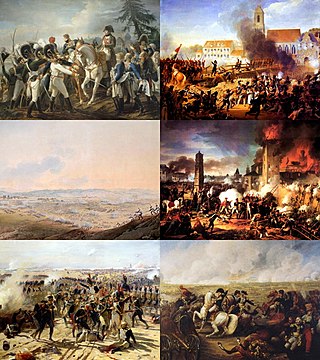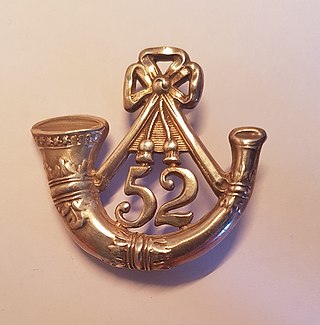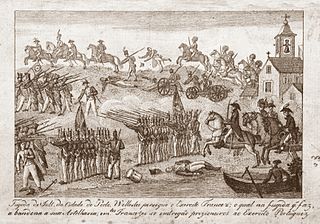
This is a non-fiction bibliography of works about the Napoleonic Wars as selected by editors.

This is a non-fiction bibliography of works about the Napoleonic Wars as selected by editors.
| External videos | |
|---|---|
First published 1978 in French

The Peninsular War (1807–1814) was the military conflict fought in the Iberian Peninsula by Spain, Portugal, and the United Kingdom against the invading and occupying forces of the First French Empire during the Napoleonic Wars. In Spain, it is considered to overlap with the Spanish War of Independence.

The Hundred Days, also known as the War of the Seventh Coalition, marked the period between Napoleon's return from eleven months of exile on the island of Elba to Paris on 20 March 1815 and the second restoration of King Louis XVIII on 8 July 1815. This period saw the War of the Seventh Coalition, and includes the Waterloo Campaign and the Neapolitan War as well as several other minor campaigns. The phrase les Cent Jours was first used by the prefect of Paris, Gaspard, comte de Chabrol, in his speech welcoming the king back to Paris on 8 July.

The Battle of Ulm on 16–19 October 1805 was a series of skirmishes, at the end of the Ulm Campaign, which allowed Napoleon I to trap an entire Austrian army under the command of Karl Freiherr Mack von Leiberich with minimal losses and to force its surrender near Ulm in the Electorate of Bavaria.

The War of the Fifth Coalition was a European conflict in 1809 that was part of the Napoleonic Wars and the Coalition Wars. The main conflict took place in Central Europe between the Austrian Empire of Francis I and Napoleon's French Empire. The French were supported by their client states—the Kingdom of Italy, the Confederation of the Rhine and the Duchy of Warsaw. Austria was supported by the Fifth Coalition which included the United Kingdom, Portugal, Spain, and the Kingdoms of Sardinia and Sicily, although the latter two took no part in the fighting. By the start of 1809 much of the French army was committed to the Peninsular War against Britain, Spain and Portugal. After France withdrew 108,000 soldiers from Germany, Austria attacked France to seek the recovery of territories lost in the 1803–1806 War of the Third Coalition. The Austrians hoped Prussia would support them, having recently been defeated by France, but Prussia chose to remain neutral.

A military column is a formation of soldiers marching together in one or more files in which the file is significantly longer than the width of ranks in the formation. The column formation allows the unit rapid movement and a very effective charge, and it can quickly form square to resist cavalry attacks, but by its nature only a fraction of its muskets are able to open fire.

The Battle of Zornoza, fought on 31 October 1808, was one of the opening engagements in Napoleon's invasion of Spain. The battle was intended to encircle and crush the left wing of the Spanish front. The Spanish infantry was swiftly thrown back but escaped in good order.

The 52nd (Oxfordshire) Regiment of Foot was a light infantry regiment of the British Army throughout much of the 18th and 19th centuries. The regiment first saw active service during the American War of Independence, and were posted to India during the Anglo-Mysore Wars. During the Napoleonic Wars, the 52nd were part of the Light Division, and were present at most major battles of the Peninsula campaign, becoming one of the most celebrated regiments, described by Sir William Napier as "a regiment never surpassed in arms since arms were first borne by men". They had the largest British battalion at Waterloo, 1815, where they formed part of the final charge against Napoleon's Imperial Guard. They were also involved in various campaigns in India.
Philip J. Haythornthwaite FRHistS is an author and historical consultant specialising in military history, uniforms, and equipment. While his main area of research is the Napoleonic Wars, his list of publications covers a wider period from the English Civil War through to 1939.
David Geoffrey Chandler was a British historian whose study focused on the Napoleonic era.

The British Army during the Napoleonic Wars experienced a time of rapid change. At the beginning of the French Revolutionary Wars in 1793, the army was a small, awkwardly administered force of barely 40,000 men. By the end of the period, the numbers had vastly increased. At its peak, in 1813, the regular army contained over 250,000 men. The British infantry was "the only military force not to suffer a major reverse at the hands of Napoleonic France."

The Battle of Benavente was a cavalry clash in which the British cavalry of Lord Paget defeated the elite Chasseurs à cheval of the French Imperial Guard during the Corunna Campaign of the Peninsular War. The French chasseurs were broken and forced into the River Esla; their commanding officer, General Lefebvre-Desnouettes, was captured. The action was the first major incident in the British army's harrowing retreat to the coast and ultimate evacuation by sea.
Digby George Smith, who also used the pseudonym Otto von Pivka, was a British military historian. The son of a British career soldier, he was born in Hampshire, England, but spent several years in India and Pakistan as a child and youth. As a "boy soldier", he entered training in the British Army at the age of 16. He was later commissioned in the Royal Corps of Signals, and held several postings with the British Army of the Rhine.

Arthur Wellesley, 1st Duke of Wellington,, was one of the leading British military and political figures of the 19th century. Often referred to solely as "The Duke of Wellington", he led a successful military career in the Indian subcontinent during the Fourth Anglo-Mysore War (1798–99) and the Second Anglo-Maratha War (1803–1805), and in Europe during the Napoleonic Wars (1803–1815).

The Anglo-Portuguese Army was the combined British and Portuguese army that participated in the Peninsular War, under the command of Arthur Wellesley. The Army is also referred to as the British-Portuguese Army and, in Portuguese, as the Exército Anglo-Luso or the Exército Anglo-Português.
The 1st Cavalry Brigade was a brigade of the British Army. It served in the Napoleonic Wars, the Anglo-Egyptian War, the Boer War and in the First World War when it was assigned to the 1st Cavalry Division.

The 2nd Cavalry Brigade was a brigade of the British Army. It served in the Napoleonic Wars, the Boer War and in the First World War when it was assigned to the 1st Cavalry Division.

Pierre Thouvenot was a French Army officer who served with distinction in the American Revolutionary War. He fled from France during the revolution but returned under an amnesty and went on to serve in Napoleonic Wars. Thouvenot is most famous for his defence of Bayonne in 1814 and the sortie he made when the war was all but over, which drew criticism from both sides, particularly from the Duke of Wellington, who branded him a "blackguard".